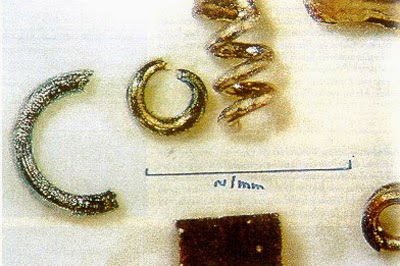| Online: | |
| Visits: | |
| Stories: |
Do thousands of mystery objects found in Russia prove ancient alien theory?
For many years now, researchers in our field have been suggesting that artifacts left by extraterrestrial visitors might be found in geological deposits. Much evidence has been found, principally by Dr. Johannes Fiebag (1,2), from apparently paradoxical events in the Earth’s history, that genetic manipulation experiments have been carried out over hundreds of millions of years by extraterrestrial, which culminated in the creation of us humans.
 |
Unfortunately for us, any discovery of possibly technical artifacts from ancient times would seem to be very unlikely. For the geological events of only the last million years are documented today in a mere few centimeters of sedimentary strata. Even as regards very recent events – I am thinking of the end of the Second World War – we aware of how quickly technical objects can disappear. Weapons, ammunition, and even large finds are already almost completely rusted away and disintegrating. In view of this, the finds made recently in Russia are all the more astonishing. In the years 1991-1993, gold prospectors on the small river Narada, on the eastern side of the Ural mountains, have found unusual, mostly spiral-shaped objects. The size of these things ranges from a maximum of 3 cm (1.2 in.) down to an incredible 0.003 mm, about 1/10,000th of an inch! To date, these inexplicable artifacts have been found in their thousands at various sites near the rivers Narada, Kozhim, and Balbanyu, and also by two smaller streams named Vtvisty and Lapkhevozh, mostly at depths between 3 and 12 meters (10 and 40 ft.) The spiral-form objects are composed of various metals: the larger ones are of copper, while the small and very small ones are of the rare metals tungsten and molybdenum.
Tungsten has a high atomic weight, and is also very dense, with a melting point of 3410 deg. C (6100 deg. F). It is used principally for the hardening of special steels, and in unalloyed form for the filaments of light bulbs. Molybdenum also has a high density, and a respectable melting point of 2650 deg. C (4740 deg. F). This metal too is used for hardening steels and giving them corrosion-resistant properties, these being used principally for highly-stressed weapon parts and vehicle armor. At the present time, these more-than-mysterious objects are being investigated by the Russian Academy of Sciences in Syktyvka (capital city of the former Soviet Republic of Komi), Moscow, St. Petersburg, and also a scientific institute in Helsinki, Finland. Exact measurements of these often microscopically-small objects have shown that the dimensions of the spirals are in the so-called Golden Mean ratio. Since ancient classical times this fraction has been the “iron rule” in architecture and geometry. Its usefulness is in the fact that if a certain length is divided into two using this ratio, the ratio of the original length to the larger piece is the same as that of the larger piece to the smaller piece. Quite apart from such subtleties, these objects are obviously the product of an inexplicable and highly advanced technology; they bear remarkable resemblance to control elements used in micro-miniature devices in our very latest technology, so-called nanomachines. This technology is still in its infancy with us, but already engineers are thinking of applications which are pure science-fiction. Among other things, they envisage constructing microprobes for use in medicine which can be implanted, such as for carrying out operations inside blood vessels which are not possible with present surgical techniques.

Source: http://www.ascensionearth2012.org/2014/06/do-thousands-of-mystery-objects-found.html









“Among other things, they envisage constructing microprobes for use in medicine which can be implanted”. Already patented and legally approved.